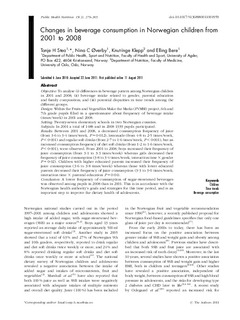| dc.contributor.author | Stea, Tonje H. | |
| dc.contributor.author | Øverby, Nina Cecilie | |
| dc.contributor.author | Klepp, Knut-Inge | |
| dc.contributor.author | Bere, Elling | |
| dc.date.accessioned | 2013-02-06T13:37:36Z | |
| dc.date.available | 2013-02-06T13:37:36Z | |
| dc.date.issued | 2012 | |
| dc.identifier.citation | Stea, T.H., Øverby, N.C., Klepp, K.I., & Bere, E. (2012). Changes in beverage consumption in Norwegian children from 2001 to 2008. Public Health Nutrition, 15(3), 379-385. | no_NO |
| dc.identifier.uri | http://hdl.handle.net/11250/139033 | |
| dc.description.abstract | Objective: To analyse (i) differences in beverage pattern among Norwegian children in 2001 and 2008; (ii) beverage intake related to gender, parental education and family composition; and (iii) potential disparities in time trends among the different groups.
Design: Within the Fruits and Vegetables Make the Marks (FVMM) project, 6th and 7th grade pupils filled in a questionnaire about frequency of beverage intake (times/week) in 2001 and 2008.
Setting: Twenty-seven elementary schools in two Norwegian counties.
Subjects: In 2001 a total of 1488 and in 2008 1339 pupils participated.
Results: Between 2001 and 2008, a decreased consumption frequency of juice (from 3.6 to 3.4 times/week, P=0.012), lemonade (from 4.8 to 2.5 times/week, P<0.001) and regular soft drinks (from 2.7 to 1.6 times/week, P<0.001), but an increased consumption frequency of diet soft drinks (from 1.2 to 1.6 times/week, P=0.001), were observed. From 2001 to 2008, boys increased their frequency of juice consumption (from 3.1 to 3.3 times/week) whereas girls decreased their frequency of juice consumption (3.8 to 3.4 times/week; interaction time x gender P=0.02). Children with higher educated parents increased their frequency of juice consumption (3.6 to 3.8 times/week) whereas those with lower educated parents decreased their frequency of juice consumption (3.3 to 3.0 times/week; interaction time x parental education P=0.04).
Conclusion: A lower frequency of consumption of sugar-sweetened beverages was observed among pupils in 2008 than in 2001. This is in accordance with the Norwegian health authority's goals and strategies for this time period, and is an important step to improve the dietary health of adolescents. | no_NO |
| dc.language.iso | eng | no_NO |
| dc.publisher | Cambridge University Press | no_NO |
| dc.title | Changes in beverage consumption in Norwegian children from 2001 to 2008 | no_NO |
| dc.type | Journal article | no_NO |
| dc.type | Peer reviewed | no_NO |
| dc.rights.holder | © 2011 The Author(s) | |
| dc.subject.nsi | VDP::Medical disciplines: 700::Health sciences: 800::Nutrition: 811 | no_NO |
| dc.source.pagenumber | 379-385 | no_NO |
| dc.source.volume | 15 | no_NO |
| dc.source.journal | Public Health Nutrition (PHN) | no_NO |
| dc.source.issue | 3 | no_NO |
| dc.identifier.doi | https://doi.org/10.1017/S1368980011001959 | |
